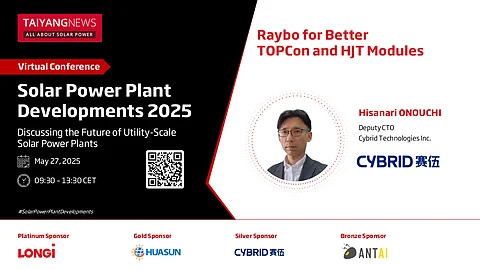

Cybrid at TaiyangNews Virtual Conference on May 27, 2025
Hisanari Onouchi, Deputy CTO at Cybrid Technologies, will be participating in the TaiyangNews Solar Power Plant Developments 2025 Virtual Conference to be held on Tuesday, May 27, 2025 from 09:30 – 13:30 CET. He will be speaking on the topic: Raybo for Better TOPCon and HJT Modules.
This half-day online conference will bring together experts from across the industry – developers, IPPs, manufacturers, and consultants – to explore the latest trends and strategies shaping the future of utility-scale solar.
Click here to register for free.
Leading vertically integrated solar manufacturer GCL Group has signed a strategic cooperation agreement with Soochow University to establish the Jiangsu Provincial Key Laboratory for Advanced Negative-Carbon Technologies.
The lab will integrate Soochow University’s strengths in material science, chemistry, and chemical engineering with GCL’s industry expertise in new energy strategy, capital operation, and commercialization. Key research areas for the lab will include photovoltaic (PV) technology applications, PV-catalysis coupling, and photo-thermal synergetic catalysis.
The collaboration also aims to build a comprehensive innovation ecosystem covering the entire chain, from research to application, through co-developing national-level research projects, sharing large-scale instruments, and implementing a joint talent recruitment mechanism.
Recently, GCL’s Inner Mongolia granular silicon facility was certified for low carbon footprint by France-based ADEME (see GCL Technology Sets New Global Record For Low-Carbon Granular Silicon).
Large power developer China Huadian has announced that its subsidiary has completed the hoisting of the first grid-connected platform for its 1.8 GW offshore solar pilot project in Qinhuangdao, marking the start of large-scale construction. The project is located off the coast of Changli County in Hebei Province, with water depths ranging from 6 to 15 meters and a total planned investment of RMB 14.4 billion ($2 billion).
The full project, consisting of 4 subprojects, is expected to generate 2.75 billion kWh annually once completed. JA Solar and Huasun are supplying 500 MW and 300 MW of dedicated offshore PV modules, respectively, to this project.
Recently, China Huadian’s subsidiary Huadian New Energy received approval to list on the main board of the Shanghai Stock Exchange (see China Solar PV News Snippets).
The Ecology and Environment Bureau of Yibin City, Sichuan Province, has approved the environmental impact assessment (EIA) report for Astronergy’s 5 GW smart module manufacturing facility. The company is investing a total of RMB 1.5 billion ($207.2 million) in this plant that will be constructed over 13.3 hectares by a local subsidiary of Astronergy. When complete, it will produce n-type monocrystalline silicon modules with an average power conversion efficiency of 23.5%.
According to its recently published 2024 Sustainability Report, Astronergy’s cumulative module shipments exceeded 130 GW by the end of 2024 (see China Solar PV News Snippets).
Leading solar PV manufacturer Trinasolar has commissioned a ‘PV-storage-charging-discharge’ integrated microgrid demonstration station at its headquarters, showcasing a smart, clean energy ecosystem. The system includes 196 kW of PV capacity – 184 kW from reused modules over 15 years old (still >87% efficient) and 12 kW of BIPV panels on curtain walls. It also features a 125 kW / 261 kWh energy storage system with 90% efficiency, advanced fire protection, and intelligent thermal management. The microgrid supports fast/slow EV charging and Vehicle-to-Grid (V2G) bidirectional flow for energy exchange, emergency backup, and peak shaving. The setup enables high-efficiency coordination of generation, storage, and consumption, enhancing solar energy utilization and grid flexibility.
The local government of Wenshan City in Yunnan Province is seeking investment to establish a high-efficiency solar cell production facility in Guangnan County. According to the proposal, the 5 GW solar cell production line will need an investment of RMB 1.8 billion ($248.9 million) and will leverage the area’s upstream supply chain strengths.
The region already hosts a robust PV supply chain: Yuze Semiconductor has commissioned 10 GW of its planned 40 GW monocrystalline ingot and wafer project, and Seraphim has begun production on 1 GW of its planned 3 GW module factory. A local PV mounting structure project is also underway and expected to start production by October this year.
